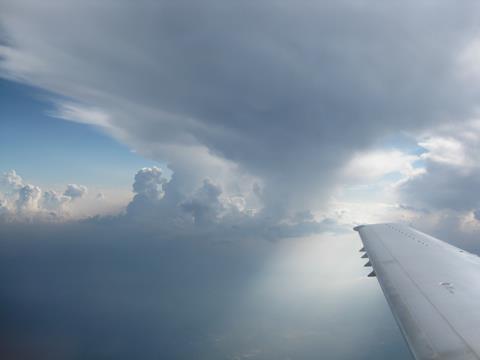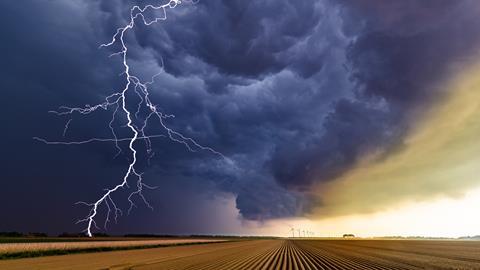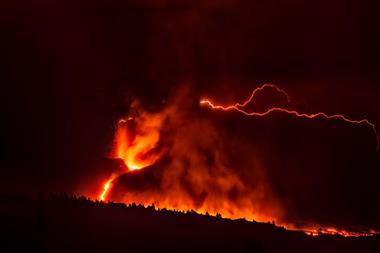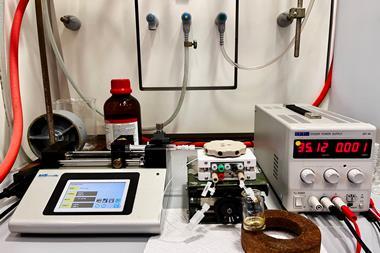Trying to understand the chemistry that occurs around immensely powerful but short-lived lightning bolts is a feat in itself. James Mitchell Crow looks for a flash of inspiration
Hollywood may yet be to option their story, but the pilots flying Nasa’s DC-8 Earth Science Laboratory aeroplane unquestionably have the right stuff. During a field campaign over the great plains of the central US in early summer 2012, the DC-8’s pilots spent their time in the air deliberately intercepting thunderstorms. The bigger the storm, the better.
Aboard each flight was a precious cargo of chemists and their analytical instruments. The Deep Convective Clouds and Chemistry campaign was a major US collaborative project studying the impact of large thunderstorms on atmospheric chemistry. By comparing the molecular make-up of air going into a thunderstorm with that coming out, the team aimed to understand the influence of powerful convection currents and lightning strikes on the atmosphere’s chemical composition. The study was expected to have relevance in subjects ranging from urban air pollution to greenhouse gas production.
‘The pilots were fantastic,’ recalls William Brune, an atmospheric chemist at Penn State University who was one of the scientific leads on the campaign, and who occupied the cockpit jump seat on many of the flights, deciding which storm to chase. Monitoring their radar, the pilots would skirt the storm’s core, circling up into the cloud anvil. ‘They don’t let you get too close, but as close as we could to maximise what we were seeing of what is coming up and out of the storm,’ Brune says. ‘Flying around these storms and into the cloud anvils, it was spectacular.’

Equally spectacular, it has proved, was the data the team collected. During several flights, the team detected baffling spikes in hydroxyl concentration around thunderstorms, orders of magnitude above any previous atmospheric measurement of the reactive radical. As the primary oxidant of Earth’s atmosphere, key to the air’s ability to cleanse itself, the finding was potentially as significant as it was puzzling.
A decade after the final flight of the field campaign, Brune and his colleagues’ latest work on the hydroxyl spikes suggests lightning’s influence on the chemistry of the atmosphere reaches far further than previously thought.
NO limits
A flash of lightning can light up the sky. Each lightning bolt is only about 2–3cm thick, but carries so much energy it heats the surrounding air to 30,000°C, far hotter than the surface of the Sun.
But in the upper troposphere, where it comes out of thunderstorms, ozone is a greenhouse gas
Where lightning meets the ground, a direct hit is easily powerful enough to blow apart mature trees – and create conditions totally different to the everyday (see box P set free below). Each bolt is equally destructive all the way along its typical 5km length through the air. Any molecule in the bolt’s vicinity will be torn apart into its component atoms. Most of those molecules will be dinitrogen (N2) and molecular oxygen (O2), the two major components of the air. As these atoms cool and recombine, they can find themselves with new partners.
‘The 30,000°C strike we see and is so evident when we look at lightning, there is very unique chemistry going on there,’ Brune says. ‘The main gas people have known about and has measures in countless missions, is nitric oxide, NO.’ Temperature is critical to lightning’s production of NO, and not just in the heating phase. ‘It requires the air to cool extremely fast, much less than a millisecond, so it essentially freezes the NO, otherwise the nitrogen goes back to N2 and the oxygen back to O2,’ Brune says.

In the aftermath of the strike, the NO can undergo a series of reactions with other oxygen and nitrogen atoms and molecules. Two key species that result are nitrogen dioxide and ozone. Each individual lightning strike may be a small event in the global scheme of atmospheric composition, but as the Earth experiences more than three million lightning strikes each day, their influence can really add up.
The effect of thunderstorms on ozone production and distribution is a research focus of Mary Barth, an atmospheric chemist at the US National Center for Atmospheric Research in Boulder, Collorado. ‘At the ground, ozone is a pollutant; it causes health problems,’ Barth says. ‘But in the upper troposphere, where it comes out of thunderstorms, ozone is a greenhouse gas,’ she says.
Thunderstorms can influence ozone levels in myriad ways. Formaldehyde, for example, a common component of air pollution, is an ozone precursor that can be drawn upward by the powerful convection of thunderstorms, Barth says. ‘But formaldehyde will partly dissolve into cloud drops, and so some of it will get rained out rather than transported up high, which shifts the balance of the chemistry,’ she adds.
To get to grips with ozone’s role as an upper troposphere greenhouse gas, a key goal is to quantify the lightning-driven production of a major precursor, lightning-derived nitrogen dioxide (NO2). As this molecule decomposes to NO under the action of sunlight, it releases an oxygen atom that can combine with dioxygen to make ozone.
‘Nitrogen oxides production by lightning has been studied for decades – how it is formed, how frequently it is formed, and how much is formed per lightning flash,’ Barth says. And yet NOx production by lightning remains highly uncertain, with reports ranging from 32–664mol NOx per flash. ‘To me, this is still fairly young field, and I think we can do a lot better,’ Barth says.

Tighten up measurements of NOx production by lightning strikes was a major target of the 2012 Deep Convective Clouds and Chemistry field campaign. ‘We’d get up in the morning, talk to the forecasters, and they’d tell us the probability of storms in different areas,’ Barth says. The team would fly out to a likely spot, sampling the air, hoping a storm would develop. ‘Then boom, the storm would come up. Oklahoma has these amazingly big storms that grow up so fast,’ Barth says.
‘The excitement when we found one – people would see the observations coming out on the computer as the data was collected,’ she says. On one flight the plane caught a small lightning strike, though nothing that couldn’t be fixed by a piece of duct tape over the resulting pinky-sized hole.
The team’s NOx measurements narrowed in on the mid-range of previous results, at 142–291mol NOx per flash. Predicting a particular storm’s NOx output, and accurately capturing the process in computer models of atmospheric processes, remains tricky. ‘At times I feel like each storm is its own individual – but we gained some better clues,’ Barth says. Thinking only in terms of NOx production per flash may miss some key parameters. ‘We think the amount of nitrogen oxides is correlated with the length of the flash,’ she says. ‘We learned things like you have more frequent lightning flashes when you have shorter flashes.’
P set free
Lightning can do more than influence the chemistry of the atmosphere. Where they touch the ground, lightning strikes can also alter the chemical composition of earth – perhaps in ways that were crucial to the emergence of life.
When Benjamin Hess was an undergrad at Wheaton College, Illinois, a family from a neighbouring town contacted the geology department after lighting struck their lawn. The strike had created a glassy material called a fulgurite, and – once excavated from the lawn – Hess adopted it as a research project. ‘I cut it open, and I literally didn’t know what I’d find,’ he says.
When you bring lightning into the picture, it allows something like phosphorus to bind to something like iron
Studying the sample by Raman spectroscopy and scanning electron microscopy, Hess found that the fulgurite contained a mineral called schreibersite, a highly reduced form of phosphorus bound to iron. Whereas phosphorus in the earth is usually essentially locked away in insoluble minerals as phosphate, schreibersite is a water-soluble phosphorus source, available for further chemistry.
According to the team’s calculations, lightning-derived reduced phosphorus on the early Earth may have been crucial in enabling the emergence of life, through formation of phosphorus-containing biomolecules including DNA, RNA, phospholipids and ATP.
From the famous studies of Stanley Miller and Harold Urey in the 1950s, lightning has often been invoked as the potential spark enabling the formation of biologically important compounds on primordial Earth. ‘Early Earth environments, and rocks in the earth in general, have so much oxygen in them that important elements like phosphorus are all bonded to oxygen,’ Hess says. ‘But when you bring lightning into the picture, heating things to thousands of degrees instantaneously, that breaks all those bonds and allows something like phosphorus to bind to something like iron in the case of schreibersite, and then suddenly it is free to react and make other molecules.’
As schreibersite is a common component of certain types of meteorite, an extraterrestrial origin of reduced, reactive phosphorus had been proposed as a potential source of the element on primordial earth. Hess’s results suggest lighting could have been an equally significant source, particularly as meteorite strikes declined as the solar system matured.
Ghost strikes
An intense summer thunderstorm can be a cathartic event. Once the lightning show is over and the rain comes to a stop, the world can often seem renewed, the air refreshed. The spike in NO concentration caused by lightning initiates a cascade of reactions that can boost the air’s supply not only of ozone, but of the atmosphere’s primary cleansing oxidant, the hydroxyl radical.
Hydroxyl’s powerful influence on the lifetime of numerous compounds in the atmosphere, both natural and anthropogenic, first came to light in the 1970s. ‘For a while, hydroxyl measurement was really top priority,’ Brune recalls. ‘The amount of hydroxyl in the atmosphere is equivalent to a few tens of parts per quadrillion, so it is very hard to measure and a lot of things can mess with your measurement.’
In many environments we have a pretty good handle on what hydroxyl does
Ultimately, two methods were developed to accurately determine hydroxyl levels in the air. One, a mass spectrometry-based method, reacts the hydroxyl with isotopically labelled SO2, making isotopically labelled sulfuric acid which can be ionised and detected. ‘It’s very bizarre, but it works,’ Brune says. Brune uses an alternate method, based on the characteristic absorption by hydroxyl by certain wavelengths of UV light. ‘We bring air in through a little pinhole, then hit it with a laser tuned to one of these absorptions.’ The trick is in the timing. ‘Light scattering from air molecules would overwhelm the fluorescence we see by a factor of a million, so we use a detector we can turn on and off really fast,’ Brune says. ‘We turn it off for the laser, wait 100 nanoseconds, then turn it on to collect the last part of hydroxyl fluorescence.’
These days we have a pretty good understanding of hydroxyl sources in the atmosphere, Brune says. ‘I have studied atmospheric hydroxyl in 16 aircraft field missions, probably two dozen tower-based missions, in cities, forests, desert areas, rural areas. In many environments we have a pretty good handle on what hydroxyl does.’
Based on that understanding one place hydroxyl was not expected was at the heart of a lightning strike, where the radical would not survive the extreme heat. ‘Any OH would all be consumed within microseconds, so it is not going to get out to do anything. It is gone so fast we couldn’t possibly detect it,’ Brune explains.
We saw these really huge OH signals when we were in the clouds, and we don’t really know what they mean
Only indirect hydroxyl production, from the cascade of reactions resulting from lightning’s NO generation, was expected. And yet, the laser-induced fluorescence instrument on board the DC-8 for the Deep Convective Clouds and Chemistry field campaign kept picking up inexplicably huge spikes in hydroxyl concentration, orders of magnitude greater than any previous atmospheric hydroxyl observation.
‘After a flight I’d go talk to my colleagues in the back of the plane running our instruments,’ Brune says. ‘They’d say “We saw these really huge OH signals when we were in the clouds, and we don’t really know what they mean.”’ At the time, the team focused on the main measurement tasks of the mission, with the odd hydroxyl results to be looked into at a later date. Brune finally found the time to revisit the data one summer. ‘But we never did look at them again – until a few years ago, just for a whim in the summer. I used some new analysis techniques we have developed, looked and the signal and said “These are real!”’
Using data from the US lightning mapping array, the timing of some hydroxyl spike events could be clearly linked to lightning strikes. Some spikes also immediately followed lightning flashes captured in footage taken by the plane’s onboard forward-facing camera. But about a third of the hydroxyl detection events were not associated with a flash.
We’re seeing OH made all around the visible spark, in subvisible discharges that are not hot
To try to make sense of the field observation, it was time to generate some artificial lightning in the lab. ‘We saw we could make lots of OH this way with sparks and whatnot,’ Brune says. Crucially, a lot of hydroxyl was detected when the lighting equipment was turned down so low that no visible spark was produced.
‘Our conclusion is that we’re seeing OH made all around the visible spark, in subvisible discharges that are not hot. There’s enough energy in these discharges, outside of this hot channel, to break apart water molecules, and that’s the hydroxyl we are seeing,’ Brune says. ‘You can imagine, when you are up in the clouds, there are all kinds of charge separation and little discharges going here and there. Some good number of those have to be producing OH
Based on the team’s measurements, subvisible lightning could be generating up to 16% of global atmospheric hydroxyl. It’s a very interesting observational result, says Francisco Gordillo-Vázquez from the Institute of Astrophysics of Andalucía in Spain. ‘We are doing experimental work in my lab to reproduce these results,’ he adds. ‘So far, these oxidants were only considered to be coming indirectly due to NO injection. Now the perspective changes because they are produced directly.’
Away with the sprites
Subvisible strikes are just one of the atmospheric electrical species recently discovered in and around thunderstorms, influencing the chemical composition of the atmosphere. The lightning bolts that we see arcing earthwards from thunderclouds are only half the story. Only in 1989, researchers showed that, above the clouds, sprites, elves and other exotic electrical species can be found dancing across the thunder tops.
In the 1920s, Scottish Nobel laureate Charles Wilson had speculated that, high in the atmosphere where the air density is lower and so electric field breakdown of the local air is easier, luminous electrical discharges called sprites could occur. In 1989, two sprites were recorded by chance over a large thunderstorm in the US Midwest.
It was subsequently shown that sprites can reach over 90km, to the base of the ionosphere. ‘We can view upper atmospheric discharges as the lost piece of the global electric circuit, connecting the troposphere with the ionosphere,’ Gordillo-Vázquez says.
In the lab, cold coronal discharges produce ozone and N2O
Could upper atmosphere transient luminous events (TLEs) be the explanation behind another mysterious observation of atmospheric chemistry? ‘Since the late 60s or so there have been reports, from time to time, of the sudden enhancement of ozone close to thunderstorm weather,’ Gordillo-Vázquez says. The reported observations of this gas were not consistent with ozone’s known indirect production via lightning-generated NO chemistry. ‘There was speculation that this enhancement of ozone could be due to lightning itself.’
Regular lightning does not directly produce significant ozone, but could these pockets of high ozone concentration be the direct results of TLEs? Unlike lightning, which is a very hot discharge, the energy in the powerful electric field of a TLE is delivered cold. ‘This is key to understanding their “chemical personality”,’ Gordillo-Vázquez says. In the lab, cold coronal discharges directly produce significant amounts of ozone and another greenhouse gas, N2O. The latter is considered the third most significant greenhouse gas after CO2 and methane.
Getting to grips with TLEs has become considerably easier with the ability to monitor them from above. ‘We are involved in a space mission called Atmosphere Space Interaction Monitor (ASIM), an instrument installed on the International Space Station since April 2018,’ Gordillo-Vázquez says. ASIM has proven to be a powerful tool for detecting corona discharges inside thunderclouds. ‘For the first time, ASIM has allowed us to understand the nature of coronas occurring in thunderclouds, and to map their distribution and frequency.’
ASIM is not equipped to measure the production of chemical species by corona discharges – but given the wide distribution of these electrical events that ASIM detected, they could be a significant natural source of greenhouse gases if their chemistry is like coronas created in the lab. ‘How important is this contribution to the chemical budget of these gases in the atmosphere? That is something still to be studied,’ Gordillo-Vázquez says. Imminent launches of new generation air quality monitoring satellites, soon to be in geostationary orbit above the US, Europe and Asia, may offer the missing piece of the data puzzle required to complete the picture.
More data would also help Brune firm up his estimates of the global significance of subvisible lightning production of hydroxyl. ‘We flew through seven storm anvils, and that’s it, all the data we have,’ he says. ‘To do this right, you would have to repeat it with an aircraft that has much more instrumentation on board to measure electric fields, charge and charge separation,’ he says. A broader range of thunderstorms, including tropical storms where most lightning occurs, would need to be sampled. ‘It’s possible, but this mission has to get in the queue.’
But the real payoff, says Barth, could be to put these instruments on one of the aeroplanes built to fly right into thunderstorms, rather than skirting around them. ‘Most of the time we are looking at things in the air before it gets into the storm, and in the air downwind of the top of the storm, and you have to make your own conclusions as to what happens in between,’ she says. ‘I would love to have the chemical composition inside that storm, from a field campaign with a storm penetrating aircraft.’
James Mitchell Crow is a science writer based in Melbourne, Australia













No comments yet